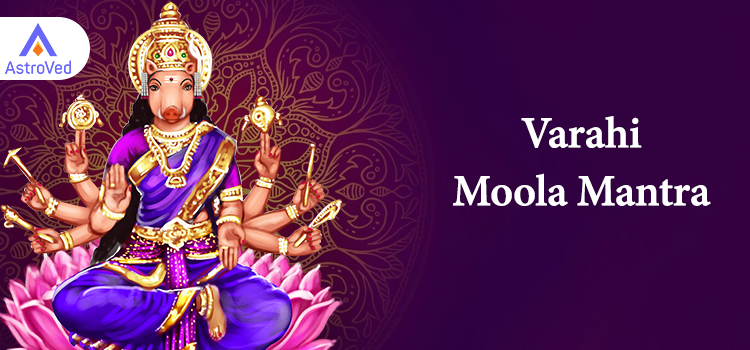Goddess Varahi, an incarnation of Goddess Parvati, is believed to have emerged from Lord Vishnu’s boar avatar, making her one of his formidable Shakti energies. Alongside Vaishnavi and Narasimhi, she represents the trio of his divine consorts. Varahi embodies the energy of Yama, the God of Death, and stands as a prominent figure among the Sapta Matrikas and the Ashta Matrikas. This article explores the multifaceted significance of Goddess Varahi across various religious traditions and delves into the empowering Varahi Moola Mantra.

Varahi in Hinduism:
Varahi’s visage, characterized by a boar-like countenance and a dark complexion reminiscent of storm clouds, mirrors her association with fierce energy. Adorned with a Karanda-Makuta crown and coral jewelry, she brandishes the Hala and Sakti while seated beneath a Kalpaka tree on a Peetam. The Vishnudharmottara text details her six hands, each bearing symbolic implements like the Danda, Khadga, Khetaka, and Pasa, while the remaining display the Abhaya and Varada mudras. An elephant, her emblem and mount, further symbolizes her essence.
Varahi in Other Traditions:
Goddess Varahi extends her influence beyond Hinduism. In Tibetan Buddhism, she manifests as a Dakini, an enlightened and compassionate entity revered for her protective attributes. Devotees believe she possesses the ability to interpret omens and prophecies, aiding individuals in transcending material attachments, including greed and lust.
Significance of Varahi:
As a member of the Sapta Matrikas, Varahi embodies controlled courage and fearlessness, serving as a reminder to confront challenges without succumbing to arrogance or greed. Worship and meditation upon Varahi help individuals recognize that such negative traits do not define their core nature. In Hindu mythology, Varahi, alongside the Sapta Matrikas, was created by Goddess Durga to vanquish the demon Raktabija, a testament to her formidable power.
The Varahi Moola Mantra:
Om Aim Hreem Shreem
Aim Gloum Aim
Namo Bhagavathi
Varthali Varthali
Varahi Varahi
Varahamuki Varahamuki
Anthe Anthini Namaha
Runthe Runthini Namaha
Jambe Jambini Namaha
Mohe Mohini Namaha
Sthambe Sthambini Namaha
Sarvadusta Pradustanaam Sarvesaam
Sarva Vaak Sidha Sakchur
Mukagathi Jihwa
Stambanam kuru Kuru
Seegram Vasyam
Aim Gloum
Taha, iTaha, thaha, Thaha
Hum Astraya phat Swaha ||
Ithi Sri Maha Varahi Moola Mantra ||
Chanting the Varahi Moola Mantra, be it thrice, twenty-one times, or a hundred and eight times daily, holds immense spiritual significance. Devotees offer pomegranate fruits and lemon rice as naivedya. For those seeking the blessings of Varahi, a continuous practice for forty-eight days is advised.
Benefits of Varahi Moola Mantra:
Devotees believe that invoking Goddess Varahi during the auspicious Brahma muhurta at 4 am can yield transformative outcomes. The practice is said to offer a myriad of benefits, including protection from malevolent forces, removal of the evil eye, safeguarding against accidents, and bestowing prosperity, courage, and confidence.
Conclusion:
The Varahi Moola Mantra stands as a powerful invocation, beckoning the blessings and protection of Goddess Varahi. Rooted in ancient wisdom and revered across diverse traditions, it serves as a beacon of courage, fearlessness, and empowerment for those who seek its divine resonance.